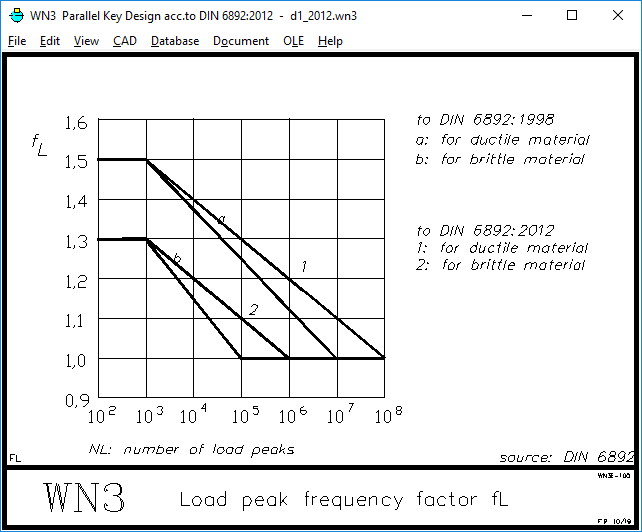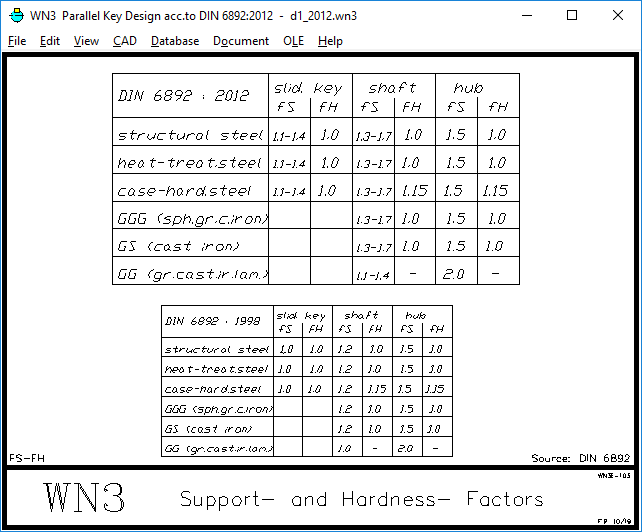
 | English
| Deutsch
| English
| Deutsch
WN3, WN11: DIN 6892:2012 and Quick3 View

WN3 got a new Quick3 view, and was updated from DIN 6892 edition 1998 to DIN 6892: 2012. The friction factor KR is now entered as KRmax and KReq. Previously, KR was considered only at Fmax, at Feq, however, KReq = 1. The friction factor KR is used when the torque transmission by parallel keys is supported by a transition fit or press fit.
There were also changes in support factor fS, hardness influence factor fH, load alternation factor fW, load peak frequency factor fL. The new factors and curves according to DIN 6892: 2012 were additionally drawn in the help images, so you have old and new DIN data in one image. Since the factors fS, fH, fW, fL are also used in WN2, WN6, WN7, WN8, WN9, WN10, WN11, WN12 in the strength calculation, the corresponding help screens have also been updated there.
WN3, WN11, WN2, WN8, WN9, WN10: Calculate fW and fL from NW and NL

The alternating load factor fW and the peak load factor fL no longer needs to be read from the diagrams in help screens FW and FL. You can now enter the number of peak loads NL and the number of load direction changes NW. Then click on the "<" button to calculate fW or fL. NL and NW can also be entered with a decimal exponent, e.g. 1E4 or 10E3 instead of 10000.
WN2, WN6, WN7, WN8, WN9, WN10, WN11, WN12: Auxiliary image Update


The help screens for the fS, fH, fW, fL have been updated in accordance with DIN 6892: 2012.

TOL1: New Error message "upper tol. < lower tol.".
If you have accidentally entered a lower value for the upper tolerance than for the lower tolerance, an error message appears immediately.
FED7: Access Violation Error Message in Module WFED7.EXE
In rare cases, when the calculated sum of coils differs from the total number of coils, an access violation occurred. If this happens to you too, please send the .fd7 file and a screenshot of the error message, then you will receive a free update to the latest version.
GR2: New software for eccentric gears
Eccentric gears are suitable for gearboxes with a large gear ratio with low backlash, with self-locking and centric axes.
On an eccentric gear, a planetary wheel rolls on a ring gear. For a large gear ratio, the number of teeth of the planetary gear wheel is only 1 or 2 teeth smaller than that of the ring gear. The ring gear is fixed, the drive shaft with eccentric drives the planet wheel. The output shaft transfers the rotation of the planetary gear around the center, in GR2 by means of pins and rollers on a bolt circle. Alternatively possible would be one or more springs (with reduced torsional rigidity).
The gearing must be calculated with ZAR1+ if you choose involute gearing. GR2 generates zar files that can be opened directly in ZAR1+.
GR2 calculates load and life of 5 rolling bearings (2 for drive shaft, 2 for output shaft, 1 for planetary gear on eccentric).
For a model, STL files of the items are generated for 3D printing.

GR2 is available from 15.11.2019 for the price of 550 EUR for the single user license
Drive technology for the electric bicycle
Do you already have a pedelec? If not: buy, you have to have. Initially reviled as a "pensioner's bycicle", today also preferred by performance mountain bikers. Amazing how far you can get with half a kilowatt hour of energy in the battery. No wonder, a pedelec weighs only 25 kg, an electric car, however, more than 50 times. While you have to tow an electric car, when the battery is empty and no charging station in sight, you can continue on the pedelec with muscle power.
Earlier pedelecs had the engine mostly in the rear hub, today seems to have prevailed the "middle engine" at the bottom bracket. No good development, I think. Mid-engines have a gearbox for the transmission in the slow, with the help of derailleur is then translated back into the fast. The only disadvantage of a wheel hub motor, however, is too little torque on the mountain. Torque specifications of mid-engine and hub motor, however, you can not compare: In a mid-engine with 75 Nm of torque on the pedal there are after translation 2: 1 in the fast just 37 Nm at the rear wheel. In the fastest gear 75 * 11/36 = 23 Nm, in crawl speed 75 * 34/36 = 70 Nm. With the mid-engine with drive on the pedals, the unified torque of the engine and the cyclist runs through the derailleur. This means high load of chain and sprockets with correspondingly high wear. When changing from a bicycle to a mid-engined pedelec, you have to relearn when shifting: if you take off load to shift, the engine will continue to run for about a second, and an ugly crack will show you knocking the chain under load. Switching back on the mountain is a problem with the mid-engine bike. Pedelecs with mid-engine have a maximum of 10 gears, because you can not overturn the drive sprocket. When Pedelec with hub motor, however, you can turn his usual 3x10 gears. The hub motor even facilitates the shift here, because it takes away load.
A better technical solution than a mid-engine would be a hub motor with gear shift (1 additional gear would probably be sufficient) which switches automatically, depending on the speed and treading power and pedaling on the pedals. With a hub motor recuperation would be possible, the regeneration of braking energy. This should be designed by means of highly geared transmission so that you can dispense with disc brakes completely. Let's see what the future brings. Maybe a two-wheel drive with hub motors with integrated automatic transmission.
And in the battery unit one could integrate keyless-go and alarm in case of shock. Or even more comfortable a GPS with bike path and road map in the display and location by phone in case of theft.
Consumption data for plug-in hybrid cars
In plug-in hybrid cars is advertised with the favorable fuel consumption and low CO2 emissions, the electric power consumption is often not mentioned. As if electricity was free. And be generated completely CO2-free.
If you google "hybrid cars", the paid ads will appear first, especially Toyota with an action in Germany. "Super refuel. Pay diesel. ". Because in Germany diesel is cheaper than gasoline, Toyota refunded the difference price. Toyota states fuel consumption at a Prius plug-in hybrid (122kW) at 1.3 l / 100 km and power consumption at 10 kWh / 100km. With a petrol price of 1.40 EUR / l and an electricity price of 0.30 EUR / kWh, this is 1.82 EUR for gasoline plus, however, 3.00 EUR for electricity per 100 km.
Next, Opel is promoting a "Grandland X Hybrid4" SUV with combined fuel consumption of 1.6 l / 100 km. How much power the 300 hp and 1875 kg heavy colossus consumed, you will find nowhere. If you retrieve the full 221 kW in E-mode (highway full throttle), then a 50 kWh battery in just 14 minutes drove empty.
Cost and state share for gasoline, diesel and electricity in comparison
The German energy tax for gasoline is 65.45 ct / l and for diesel 47.04 ct / l. Added to this is the 19% VAT, then makes 78 ct / l on gasoline and 56 ct / l on diesel. Why the tax for diesel is lower than for gasoline, although energy content and efficiency are higher and the exhaust gases are more toxic, understand who wants. Perhaps because of the fear that the price-conscious diesel drivers would otherwise fuel heating oil, agricultural diesel, or salad oil.
At a net price of 60 cents / liter gasoline is 60ct + 65.45ct + 19% VAT. to 1.49 Euro / l and diesel to 60 + 47.04 + 19% VAT. = 1.28 Euro / l. The tax share for gasoline in Germany is then about 60% and for diesel about 53% ..
The electricity is similar, the state share is about 55%. However, most of this is not provided by the state, but by subsidy recipients from the Renewable Energy Sources Act, which are allowed to feed their electricity at inflated prices.
How much does a kilowatt hour of gasoline and diesel cost?
To compare the costs, one must know the energy content of the fuels (converted from kJ / kg to kwh / l):
Gasoline: 9.3 kWh / l
Diesel: 10 kWh / l
With a gasoline price of 1.50 EUR and a diesel price of 1.30 EUR then costs
1 kWh of gas: 16 cents
1 kWh of diesel: 13 cents
This is cheaper than electricity (about 30 ct / kWh) and applies only at 100% efficiency. For example, if gasoline, diesel and electricity are not used for locomotion, but for heating. But it should be compared to the mechanical work that brings a car on the road. Therefore, it should be considered that the efficiency of internal combustion engines is much worse than that of electric motors.
Efficiency of cars: petrol engine about 30%, diesel about 40%, electric about 80%
Thus, the energy costs for 1 kWh of mechanical work put on the road would be:
Car petrol engine: 0.53 Euro / kWh (0.16 / 0.3) corresponds to 0.36 l of gasoline
Passenger car diesel: 0.32 Euro / kWh (0.13 / 0.4) corresponds to 0.25 l diesel
Car Electric: 0.38 Euro / kWh (0.3 / 0.8) equals 1.25 kWh of input electricity
According to this, the most poisonous combustor, the diesel, remains the cheapest means of transport. Whether that can be so politically desired? In winter when the heating is turned on, the energy cost balance for the burners in comparison to the electric motor even cheaper, because the waste product heat is blown into the interior for free.
Emission problem with cold engine
While the diesel fraud with excessive exhaust emissions is largely uncovered, one can blow quite high exhaust emissions completely legally through the exhaust: During the warm-up phase, the catalyst is ineffective until it has reached operating temperature. Unfortunately, especially in inner cities, on an exhaust level with pedestrians, many cars on the road do not even reach their operating temperature. Because the drivers only buy buns by car or bring the kids to the kindergarten. From the incomplete combustion also extremely poisonous gases such as carbon monoxide are blown through the exhaust.
Brexit effects
Question: What effect does Brexit have on the software industry?
Answer: none at all, if the product software is delivered via the Internet (non-taxable sales). The UK's exit from the EU even brings a relief of bureaucracy, because every single sale in EU states with the customer's VAT number had to be reported as an intra-Community supply to the "Federal Central Tax Office (BZSt)" in the "Summary Report (ZM)" ,